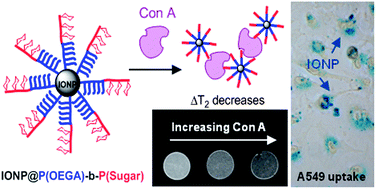Magnetic nanoparticles with diblock glycopolymer shells give lectin concentration-dependent MRI signals and selective cell uptake†
Abstract
Multivalent glycopolymers exhibit a strong affinity for specific lectin proteins depending on their specific carbohydrate functionality. In this work, we report a facile one-pot synthesis of diblock PEG-glycopolymers using a combination of Cu(0) mediated living radical polymerization and click chemistry to attach three different carbohydrates, α-D-mannose, α-D-glucose and β-D-glucose, to iron oxide nanoparticle (IONP) surfaces. The resultant IONP@P(OEGA)-b-P(sugar) nanoparticles were then extensively characterized using a wide range of analytical techniques, including ATR-FTIR, XPS and TEM. Interestingly, α-D-mannose functionalized IONPs, (IONP@P(OEGA)-b-P(N3Man)), exhibited high r2 transverse relaxivity when measured in a 9.4 T MRI. A significant change in T2 relaxation was observed following binding to the lectin concanavalin A (Con A), with a response proportional to the lectin concentration. The results reported herein indicate that the specific binding of lectin to nanoparticle surfaces can be quantitatively detected using MRI, showing significant promise for future diagnostic applications. Additionally we found a significant improvement in cell uptake for IONPs functionalized with α-D-mannose, in a lung cancer cell line (A549).


 Please wait while we load your content...
Please wait while we load your content...